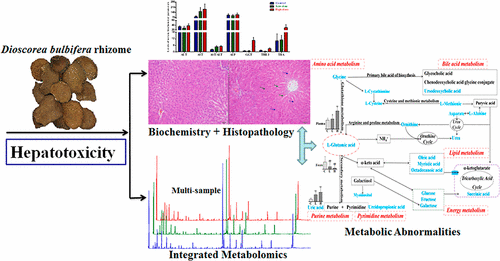当前位置:
X-MOL 学术
›
Chem. Res. Toxicol.
›
论文详情
Our official English website, www.x-mol.net, welcomes your feedback! (Note: you will need to create a separate account there.)
Investigation of Dioscorea bulbifera Rhizome-Induced Hepatotoxicity in Rats by a Multisample Integrated Metabolomics Approach
Chemical Research in Toxicology ( IF 4.1 ) Pub Date : 2017-09-22 00:00:00 , DOI: 10.1021/acs.chemrestox.7b00176 Dong-Sheng Zhao 1 , Li-Long Jiang 1 , Ya-Xi Fan 1 , Ling-Li Wang 1 , Zhuo-Qing Li 1 , Wei Shi 1 , Ping Li 1 , Hui-Jun Li 1
Chemical Research in Toxicology ( IF 4.1 ) Pub Date : 2017-09-22 00:00:00 , DOI: 10.1021/acs.chemrestox.7b00176 Dong-Sheng Zhao 1 , Li-Long Jiang 1 , Ya-Xi Fan 1 , Ling-Li Wang 1 , Zhuo-Qing Li 1 , Wei Shi 1 , Ping Li 1 , Hui-Jun Li 1
Affiliation

|
The use of herbal medicines continues to expand globally, meanwhile, herb-associated hepatotoxicity is becoming a safety issue. As a conventional Chinese medicinal herb, Dioscorea bulbifera rhizome (DBR) has been documented to cause hepatic toxicity. However, the exact underlying mechanism remains largely unexplored. In the present study, we aimed to profile entire endogenous metabolites in a biological system using a multisample integrated metabolomics strategy. Our findings offered additional insights into the molecular mechanism of the DBR-induced hepatotoxicity. We identified different metabolites from rat plasma, urine, and feces by employing gas chromatography-mass spectrometry in combination with multivariate analysis. In total, 55 metabolites distributed in 33 metabolic pathways were identified as being significantly altered in DBR-treated rats. Correlation network analysis revealed that the hub metabolites of hepatotoxicity were mainly associated with amino acid, bile acid, purine, pyrimidine, lipid, and energy metabolism. As such, DBR affected the physiological and biological functions of liver via the regulation of multiple metabolic pathways to an abnormal state. Notably, our findings also demonstrated that the multisample integrated metabolomics strategy has a great potential to identify more biomarkers and pathways in order to elucidate the mechanistic complexity of toxicity of traditional Chinese medicine.
中文翻译:

多样品综合代谢组学方法研究薯os根茎诱导的大鼠肝毒性
草药的使用在全球范围内不断扩大,与此同时,与草药相关的肝毒性正在成为安全问题。作为传统中草药,薯Di根茎(DBR)已被证明可引起肝毒性。但是,确切的潜在机制在很大程度上仍未得到开发。在本研究中,我们旨在使用多样本综合代谢组学策略在生物系统中分析整个内源性代谢物。我们的发现为DBR诱导的肝毒性的分子机制提供了更多的见解。我们通过采用气相色谱-质谱联用多变量分析,从大鼠血浆,尿液和粪便中鉴定出不同的代谢物。总共,在DBR治疗的大鼠中,发现分布在33个代谢途径中的55种代谢物发生了显着变化。相关网络分析表明,肝毒性的枢纽代谢产物主要与氨基酸,胆汁酸,嘌呤,嘧啶,脂质和能量代谢有关。这样,DBR通过将多种代谢途径调节为异常状态来影响肝脏的生理和生物学功能。值得注意的是,我们的研究结果还表明,多样品整合代谢组学策略在识别更多生物标志物和途径方面具有巨大潜力,以阐明中药毒性的机械复杂性。
更新日期:2017-09-23
中文翻译:

多样品综合代谢组学方法研究薯os根茎诱导的大鼠肝毒性
草药的使用在全球范围内不断扩大,与此同时,与草药相关的肝毒性正在成为安全问题。作为传统中草药,薯Di根茎(DBR)已被证明可引起肝毒性。但是,确切的潜在机制在很大程度上仍未得到开发。在本研究中,我们旨在使用多样本综合代谢组学策略在生物系统中分析整个内源性代谢物。我们的发现为DBR诱导的肝毒性的分子机制提供了更多的见解。我们通过采用气相色谱-质谱联用多变量分析,从大鼠血浆,尿液和粪便中鉴定出不同的代谢物。总共,在DBR治疗的大鼠中,发现分布在33个代谢途径中的55种代谢物发生了显着变化。相关网络分析表明,肝毒性的枢纽代谢产物主要与氨基酸,胆汁酸,嘌呤,嘧啶,脂质和能量代谢有关。这样,DBR通过将多种代谢途径调节为异常状态来影响肝脏的生理和生物学功能。值得注意的是,我们的研究结果还表明,多样品整合代谢组学策略在识别更多生物标志物和途径方面具有巨大潜力,以阐明中药毒性的机械复杂性。


























 京公网安备 11010802027423号
京公网安备 11010802027423号